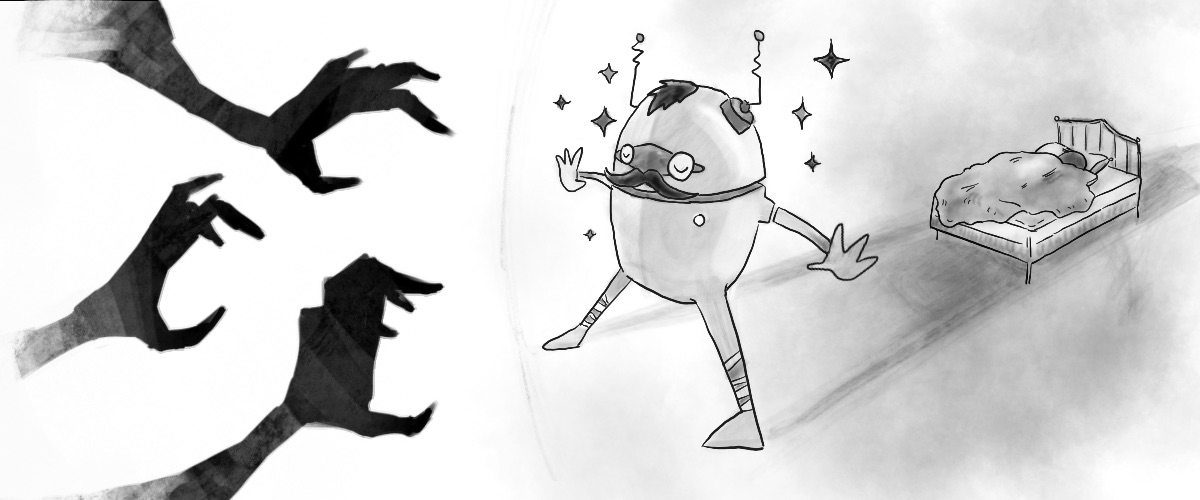By asking lots of good questions, Brendan Miller, our lead UX/UI designer, built a friendly, kind, and respectful interface that interacts with the Lully Sleep Guardian to cut down night terrors. Instead of watching, unable to help, parents can reset a healthy sleep pattern and eliminate night terrors.
Good design can create positive change. What if design can help the sleep patterns of children experiencing night terrors?
Last year we helped Lully create a smartphone operated device that cuts down night terrors by tracking and retraining children into healthy sleep patterns. It works by sending a light vibration to the child right before they would enter into unhealthy sleep. It doesn’t wake the child. The vibrations bring the child out of the troublesome sleep patterns, preventing their night terror.
Night terrors usually affect children 2-16 years old. They happen because the child’s brain goes into a dissociate state where part of the brain is awake and a part is still asleep.
During an episode, the child’s eyes are open and they’re screaming and crying, but they’re actually fast asleep. It’s terrifying, like watching an exorcism. The parents and family members try to help but instead of being able to calm and sooth, the child flails and pushes and yells. The only thing the family can do is wait and try to make sure the child doesn’t hurt themselves on a nearby object.
Sleep science didn’t have answers. Pediatricians told parents to wait it out. That it was a phase and would pass in months or years. Thankfully, Varun Boriah and Andy Rink wanted to explore further.
Varun and Andy met at the Biodesign Fellowship at Stanford. Varun had a background in engineering medical devices and Andy was an MD. They started working on how and why some kids have night terrors, and if there was a way to help them faster.
Imagine a room of spreadsheets tracking the times and habits of multiple children to analyze the night terror pattern. That’s how Lully Sleep Guardian got started. They figured if you could slightly jostle the child at the right times unique for every child, you could reset a healthy sleep pattern. Yay! Science!
They came to us to help build the interface that would interact with their device.
Four Factors Design must Address
Brendan Miller, our lead UX/UI designer, needed to design something friendly, kind, and respectful that could be used in a dark room, during frantic situations, and was smart about children’s privacy.
He asked a lot of good questions. “When is it going to be used? What are the emotions that parents would be feeling? How can we build something that respects the parent’s time? What feels safe and right for the children?”
We learned some enlightening things while designing for kids in the real world.
Consider Time of Day
Knowing when the device is going to be used can change what colors and brightness one uses when designing an interface. In the case of Lully, we used a black background and purples to not unduly wake the sleeping child. This was also good for the parents given blight light or yellow light can trick the brain into staying awake longer thinking it is daytime.
Be Polite to People Operating Your App in Stressful Circumstances
We didn’t want to create any complex flows that would limit the parent knowing exactly how and when or where to enter data. Entering data was done nearly automatically or with sliders to not overwhelm the parent. Turning on or off the device was easy with a big, clear, presant button. During a night terror, it or how to turn the device off. As well as an ever-present button for recording an impromptu night terror.
Think through all Fail Points when Connecting to IoT
Anytime you’re designing a setup flow for physical components it’s crucial to know all of the edge-cases so that the interface can clearly communicate the next step. Brendan closely worked with the engineers to understand all of the success and failure modes and plan them into the workflow.
Be Aware of Privacy Concerns
These are kids. Parents are rightfully sensitive to how kids are portrayed and where their information is used. The app allows parents to enter useful information and even upload a picture, but we made sure that was only for them. The smart algorithm on the backend sets up the times based on each individual kid and portrays them in a way that is kind, considerate, respectful and up to the parent’s discretion. The personalization is unique and it makes it feel like much more than just an app.

Sleep is incredibly important for our sanity, happiness, and functioning in general. Neuroscientist, Jeff Lliff, put it well, “While our body is still and our mind is off walking in dreams somewhere, the elegant machinery of the brain is quietly hard at work cleaning and maintaining this unimaginably complex machine.”
We enjoyed working on this important project with such a high caliber team. I hope the work of this group can help make a positive change for anyone you know dealing with night terrors. Please refer anyone that needs this solution here: http://www.lullysleep.com/
In the meantime, design your lives well and thoughtfully. And let us know if you need any help with elegant, empathetic interfaces.